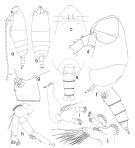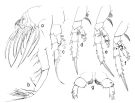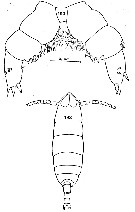|
|
 |
Fiche d'espèce de Copépode |
|
|
Calanoida ( Ordre ) |
|
|
|
Clausocalanoidea ( Superfamille ) |
|
|
|
Phaennidae ( Famille ) |
|
|
|
Cephalophanes ( Genre ) |
|
|
| |
Cephalophanes frigidus Wolfenden, 1911 (F,M) | |
| | | | | | | Syn.: | ? no Cephalophanes frigidus : Tanaka, 1960 a (p.124, figs.F, juv.F) | | | | Ref.: | | | Wolfenden, 1911 (p.284, Descr.F, figs.F); Steuer, 1926 (p.183, figs.F,M); Farran, 1929 (p.209, 254, fig.F, Rem.); Vervoort, 1957 (p.93, Rem.); Owre & Foyo, 1967 (p.58, figs.F,M); Séret, 1979 (p.110, fig.F); Park, 1983 a (p.321, figs.F, Rem.F); Chihara & Murano, 1997 (p.852, Pl.139: F); Vives & Shmeleva, 2007 (p.681, figs.F, Rem.); Park & Ferrari, 2009 (p.143, Table 3, Appendix 1, biogeography from Southern Ocean) |  issued from : G.P. Farran in British Antarctic (\"Terra Nova\") Expedition, 1910. Natural History Reports. Zoology. Vol. VIII. Crustacea., 1929. [p.254, Fig.20] Female: fifth feet.
|
 issued from : T. Park in Antarct. Res. Ser. Washington, 1983, 39 (5). [p323, Fig.3]. Female: a, habitus (lateral left side); b, idem (dorsal); c, forehead (ventral); d, idem (lateral); e, last thoracic segment and urosome (dorsal); f, posterior part of metasome with P5 and urosome (lateral left side); g, genital segment (lateral left side); h, A2; i, Md; j, Mx1.
|
 issued from : T. Park in Antarct. Res. Ser. Washington, 1983, 39 (5). [p324, Fig.4]. Female: a, Mx2; b, Mxp; c, P1 (anterior); d, P2 (posterior); e, P3 (posterior); f, P4 (posterior); g, P5 (posterior).
|
 issued from : R.N. Wolfenden in Die Marinen Copepoden der Deutschen Südpolar-Expedition 1901-1903, 1911. [p.284, Fig.46]. Female (from Antarctic continent): a, habitus (lateral); b, Mx2; c, P5.
|
 issued from : A. Steuer in Wiss. Ergebn. dt. Tiefsee-Exped. \"Valdivia\", 1926, 23. [p.184, Figs.8-14]. Female: 8, habitus (dorsal); 9, posterior part of thorax and urosome (lateral); 10, forehead (ventral); 11, P1; 12, P2; 13, P3; 14, P5.
|
 issued from : A. Steuer in Wiss. Ergebn. dt. Tiefsee-Exped. \"Valdivia\", 1926, 23. [p.185, Figs.15-17]. Male: 15, habitus (dorsal); 16, posterior part of thorax with P5 and urosome (lateral); 17, P5. L = left leg; R = right leg.
|
 Issued from : C. Séret in Thesis 3ème Cycle, UPMC, Paris 6. [Pl. XXXII, Figs.192, 193]. Female (from off Kerguelen Is.): 192, habitus (dorsal); 193, P5. Nota: The Kerguelen Islands' specimen differs from Steuer's description (1926) by only 2 or 3 spines close on surface of last segment of P5, whereas we note 2 rows of 3 to 4 srrong spines in the Steuer's specimen. More, female P5 ends by 3 teeth against 2 in Steuer, the inner is slightly shorter than the outer.
| | | | | Ref. compl.: | | | Hardy & Gunther, 1935 (1936) (p.163, Rem.); Vinogradov, 1968 (1970) (p.166); Bainbridge, 1972 (p.61, Appendix Table III: occurrence); Harding, 1974 (p.141, tab.2, gut contents); Deevey & Brooks, 1977 (p.256, Table 2, station "S"); Björnberg, 1973 (p.331, 385); Vives, 1982 (p.292); Hopkins, 1985 (p.197, Table 1, gut contents); Hopkins & Torres, 1988 (tab.1); Voronina & Kolosova, 1999 (p.71); Razouls & al., 2000 (p.343, tab.5, Appendix); Schnack-Schiel & al., 2008 (p.1045: Tab.2); Homma & Yamaguchi, 2010 (p.965, Table 2); Medellin-Mora & Navas S., 2010 (p.265, Tab. 2); Homma & al., 2011 (p.29, Table 2, 3, abundance, feeding pattern: suspension feeders); | | | | NZ: | 11 | | |
|
Carte de distribution de Cephalophanes frigidus par zones géographiques
|
| | | | | | | | |  Carte de 1996 Carte de 1996 | |
 issued from : W. Vervoort in B.A.N.Z. Antarctic Reseach Expedition, Reports - Ser. B, Vol. III, 1957 [Fig.124] issued from : W. Vervoort in B.A.N.Z. Antarctic Reseach Expedition, Reports - Ser. B, Vol. III, 1957 [Fig.124]
Chart showing the geographical distribution (white circle) in the seas surrounding the Antarctic continent.
Nota: In this chart the area frequented by whaling vessels has been hatched. The Antarctic circle (66°.5 S) has been drawn as a broken line. The numbers I to VI refer to the sectors into which the Antarctic seas are divided according to Mackintosh (1942) (after Vervoort, 1951). |
 issued from : A. Steuer in Wiss. Ergebn. dt. Tiefsee-Exped. \"Valdivia\", 1926, 23. [p.186, Fig.18]. issued from : A. Steuer in Wiss. Ergebn. dt. Tiefsee-Exped. \"Valdivia\", 1926, 23. [p.186, Fig.18].
Geograpphic distribution of cephalophanes frigidus (white circle, male and female indicated) and C. refulgens (black circle; male and female indicated). |
 Issued from : C. Séret in Thesis 3ème Cycle, UPMC, Paris 6. 1979, Annexe. [p.36]. Issued from : C. Séret in Thesis 3ème Cycle, UPMC, Paris 6. 1979, Annexe. [p.36].
Geographical occurrences of Cephalophanes frigidus in the Indian Ocean and Antarctic zone. [after publications from: Brady, 1883, 1918; Thompson, 1900; Wolfenden, 1908, 1911; With , 1915; Rosendorn, 1917; Farran, 1929; Sewell, 1929, 1947; Brady & Gunther, 1935; Steuer, 1929, 1392, 1933; Ommaney, 1936; Vervoort, 1957; Tanaka, 1960; Brodsky, 1964; Seno, 1966; Andrews, 1966; Grice & Hulsemann, 1967; Seno, 1966; Frost & Fleminger, 1968; Voronina, 1970; Zverva, 1972].
C. Séret notes the occurrence at station 56°S, 70°E. |
| | | | Loc: | | | Antarct. (Croker Passage, Peninsula, SW Atlant., Weddell Sea, Indian, SW & S Pacif.), South Georgia, sub-Antarct. (Indian, SW & SE Pacif.), SE Atlant. Atlant. (tropical), G. of Guinea, off Lagos, off Mauritania, Caribbean Colombia, Caribbean Sea, Florida, off Bermuda: Station "S" (32°10'N, 64°30'W), off E Cape Cod, Arabian Sea, Indian, Arafura Sea, Japan (Izu region), S Peru S, Bering Sea, S Aleutian Basin), S Aleutian Is. | | | | N: | 21 | | | | Lg.: | | | (10) F: 5; (15) F: 4,72-4,2; (25) F: 5; (35) F: 4,32; (42) F: 5,05-4; M: 4,05-3,7; (246) F: 4,1; (866) M: 3-4; {F: 4,00-5,05; M: 3,70-4,05} | | | | Rem.: | bathypélagique.
Sampling depth (Antarct., sub-Antarct.) : 500-2000 m.
Voir aussi les remarques en anglais | | | Dernière mise à jour : 20/02/2017 | |
|
|
 Toute utilisation de ce site pour une publication sera mentionnée avec la référence suivante : Toute utilisation de ce site pour une publication sera mentionnée avec la référence suivante :
Razouls C., Desreumaux N., Kouwenberg J. et de Bovée F., 2005-2025. - Biodiversité des Copépodes planctoniques marins (morphologie, répartition géographique et données biologiques). Sorbonne Université, CNRS. Disponible sur http://copepodes.obs-banyuls.fr [Accédé le 03 décembre 2025] © copyright 2005-2025 Sorbonne Université, CNRS
|
|
 |
 |












